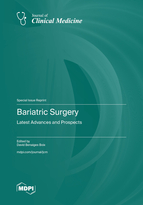Bariatric Surgery: Latest Advances and Prospects
A special issue of Journal of Clinical Medicine (ISSN 2077-0383). This special issue belongs to the section "Endocrinology & Metabolism".
Deadline for manuscript submissions: closed (30 April 2023) | Viewed by 77419
Special Issue Editor
Interests: bariatric surgery; morbid obesity; obesity; sleeve gastrectomy; gastric bypass; surgical complications; diabetes remission; hypertension remission; hypercholesterolemia remission
Special Issue Information
Dear Colleagues,
In the current situation of obesity as a worldwide pandemic, there is currently no doubt that bariatric surgery is the most effective treatment for severe obesity. In this respect, thousands of bariatric procedures are currently being performed around the world with an exponentially increasing trend. During the past several years an intense scientific activity in this field has been realized, allowing us to obtain a deeper knowledge of the effect of bariatric procedures on obesity comorbidities, a more complete view on perioperative complications, medium-term effectiveness, and new bariatric surgery techniques, among others. The scope of this Topical Collection is to provide an overview of recent advances in the field of bariatric surgery. Therefore, researchers in the field of bariatric surgery are encouraged to submit an original article (no animal research) or review to this Topical Collection (case reports and short reviews are not accepted).
Dr. David Benaiges Boix
Guest Editor
Manuscript Submission Information
Manuscripts should be submitted online at www.mdpi.com by registering and logging in to this website. Once you are registered, click here to go to the submission form. Manuscripts can be submitted until the deadline. All submissions that pass pre-check are peer-reviewed. Accepted papers will be published continuously in the journal (as soon as accepted) and will be listed together on the special issue website. Research articles, review articles as well as short communications are invited. For planned papers, a title and short abstract (about 100 words) can be sent to the Editorial Office for announcement on this website.
Submitted manuscripts should not have been published previously, nor be under consideration for publication elsewhere (except conference proceedings papers). All manuscripts are thoroughly refereed through a single-blind peer-review process. A guide for authors and other relevant information for submission of manuscripts is available on the Instructions for Authors page. Journal of Clinical Medicine is an international peer-reviewed open access semimonthly journal published by MDPI.
Please visit the Instructions for Authors page before submitting a manuscript. The Article Processing Charge (APC) for publication in this open access journal is 2600 CHF (Swiss Francs). Submitted papers should be well formatted and use good English. Authors may use MDPI's English editing service prior to publication or during author revisions.
Keywords
- bariatric surgery
- morbid obesity
- sleeve gastrectomy
- gastric bypass
- surgical complications
- diabetes remission
- hypertension remission
- hypercholesterolemia remission
- long-term results







